【精品】人教版八年级英语下册第三单元教案
人教版八年级英语下册Unit3单元教学设计
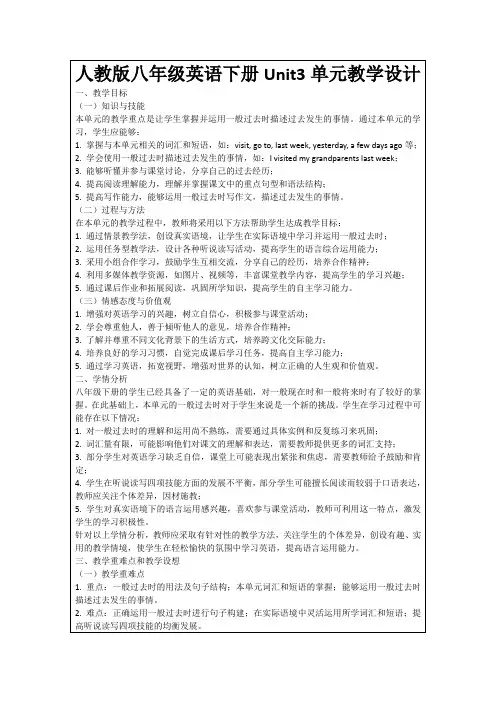
1.通过情景教学法,创设真实语境,让学生在实际语境中学习并运用一般过去时;
2.运用任务型教学法,设计各种听说读写活动,提高学生的语言综合运用能力;
3.采用小组合作学习,鼓励学生互相交流,分享自己的经历,培养合作精神;
4.利用多媒体教学资源,如图片、视频等,丰富课堂教学内容,提高学生的学习兴趣;
d.课后布置相关作业,让学生运用所学知识进行写作,提高语言运用能力。
2.针对教学难点,采取以下措施:
a.提供典型例句,分析一般过去时的句子结构,帮助学生掌握语法规则;
b.创设丰富的语境,让学生在情境中进行角色扮演,提高口语表达能力;
c.设计分层教学,针对不同水平的学生提供不同难度的练习,使每个学生都能在原有基础上得到提高;
5.通过学习英语,拓宽视野,增强对世界的认知,树立正确的人生观和价值观。
二、学情分析
八年级下册的学生已经具备了一定的英语基础,对一般现在时和一般将来时有了较好的掌握。在此基础上,本单元的一般过去时对于学生来说是一个新的挑战。学生在学习过程中可能存在以下情况:
1.对一般过去时的理解和运用尚不熟练,需要通过具体实例和反复练习来巩固;
2.学会使用一般过去时描述过去发生的事情,如:I visited my grandparents last week;
3.能够听懂并参与课堂讨论,分享自己的过去经历;
4.提高阅读理解能力,理解并掌握课文中的重点句型和语法结构;
5.提高写作能力,能够运用一般过去时写作文,描述过去发生的事情。
(二)过程与方法
4.教师带领学生进行句型替换练习,巩固一般过去时的用法。
(三)学生小组讨论
1.教师将学生分成小组,要求他们用一般过去时描述过去发生的事情,如:“What did you do last weekend?”
(完整版)英语人教版八年级下册Unit3教学设计
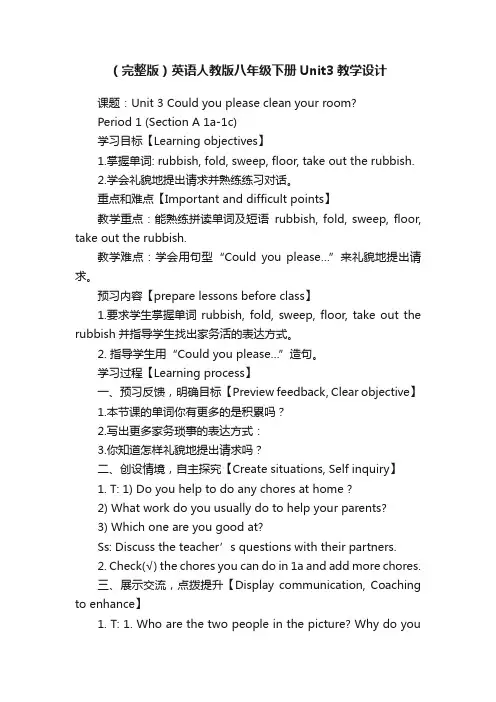
(完整版)英语人教版八年级下册Unit3教学设计课题:Unit 3 Could you please clean your room?Period 1 (Section A 1a-1c)学习目标【Learning objectives】1.掌握单词: rubbish, fold, sweep, floor, take out the rubbish.2.学会礼貌地提出请求并熟练练习对话。
重点和难点【Important and difficult points】教学重点:能熟练拼读单词及短语rubbish, fold, sweep, floor, take out the rubbish.教学难点:学会用句型“Could you please…”来礼貌地提出请求。
预习内容【prepare lessons before class】1.要求学生掌握单词rubbish, fold, sweep, floor, take out the rubbish并指导学生找出家务活的表达方式。
2. 指导学生用“Could you please…”造句。
学习过程【Learning process】一、预习反馈,明确目标【Preview feedback, Clear objective】1.本节课的单词你有更多的是积累吗?2.写出更多家务琐事的表达方式:3.你知道怎样礼貌地提出请求吗?二、创设情境,自主探究【Create situations, Self inquiry】1. T: 1) Do you help to do any chores at home ?2) What work do you usually do to help your parents?3) Which one are you good at?Ss: Discuss the teacher’s questions with their partners.2. Check(√) the chores you can do in 1a and add more chores.三、展示交流,点拨提升【Display communication, Coaching to enhance】1. T: 1. Who are the two people in the picture? Why do yousay so?2. Where are they? How do you know?2. Read the chores and add more chores.3. Use “Could you please…” to make a conversation just like Peter and his mother. 1c.4. Listen to 1b and check their answers.四、师生互动,拓展延伸【Teacher-student interaction, Development】【归纳】Make polite requests. ------ Could you please…? Yes, sure./ OK, but……【拓展】1.Can you do some dishes?2. rubbish的同义词:eg. You do talk rubbish sometimes. 胡言乱语【辨析】1. do 与make2. clean 与sweepeg. Let’s clean the house. You sweep the floor and I wash the dishes.五、达标测评, 巩固提高【Evaluation standards,Consolidation and improvement】基础题I. 根据句意及首字母提示写出单词。
英语人教版八年级下册第三单元教学设计
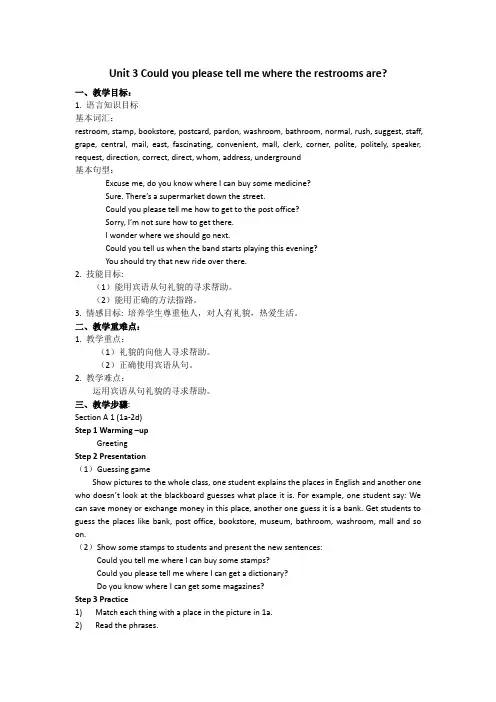
Unit 3 Could you please tell me where the restrooms are?一、教学目标:1. 语言知识目标基本词汇:restroom, stamp, bookstore, postcard, pardon, washroom, bathroom, normal, rush, suggest, staff, grape, central, mail, east, fascinating, convenient, mall, clerk, corner, polite, politely, speaker, request, direction, correct, direct, whom, address, underground基本句型:Excuse me, do you know where I can buy some medicine?Sure. There’s a supermarket down the street.Could you please tell me how to get to the post office?Sorry, I’m not sure how to get there.I wonder where we should go next.Could you tell us when the band starts playing this evening?You should try that new ride over there.2. 技能目标:(1)能用宾语从句礼貌的寻求帮助。
(2)能用正确的方法指路。
3. 情感目标: 培养学生尊重他人,对人有礼貌,热爱生活。
二、教学重难点:1. 教学重点:(1)礼貌的向他人寻求帮助。
(2)正确使用宾语从句。
2. 教学难点:运用宾语从句礼貌的寻求帮助。
三、教学步骤:Section A 1 (1a-2d)Step 1 Warming –upGreetingStep 2 Presentation(1)Guessing gameShow pictures to the whole class, one student explains the places in English and another one who doesn’t look at the blackboard guesses what place it is. For example, one student say: We can save money or exchange money in this place, another one guess it is a bank. Get students to guess the places like bank, post office, bookstore, museum, bathroom, washroom, mall and so on.(2)Show some stamps to students and present the new sentences:Could you tell me where I can buy some stamps?Could you please tell me where I can get a dictionary?Do you know where I can get some magazines?Step 3 Practice1) Match each thing with a place in the picture in 1a.2) Read the phrases.get some money get some magazineshave dinner get a dictionaryget some information about the town buy a newspaperbuy some stamps get a pair of shoesStep 4 ListeningListen and complete the conversations in the picture in 1a. Then check the answers with the whole class.Step 5 PracticeMake conversations using the information in 1a. Then talk about your own city. For example:A: Excuse me, could you please tell me how to get to the bookstore?B: Sure, just go along Main Street until you pass Center Street. The bookstore is on your right, beside the bank.A: Thanks. Do you know when the bookstore closes today?B: It closes at 7:00 p.m. today.A: Thank you!B: You’re welcome.Step 6 Listening1. Listen and number the directions in the order that you hear them.You will hear some of the directions below. Number the directions in the order you hear them.___Go to the bird floor.___ Turn left.___ Go to the second floor.___ Turn right.___ The supermarket is between the flower store and the bookstore.___ Go past the bookstore.2. Listen again. Show how the boy walks to the supermarket. Draw a line in the picture in 2a.Then get one student draw the line on the blackboard.3. Listen the third time and answer the questions.1) Excuse me, can you tell me where I can buy some medicine?2) Do you know how to go there?3) OK, great. Oh, and one more thing. Do you know when this shopping center closes tonight?4) OK, thanks a lot.Step 7 Pair workMake conversations about the other places in the picture in 2a.A: Excuse me. Can you tell me where I can buy some stamps?B: Yes, there’s a post office in this sho pping center.A: Do you know how to go there?B: Yes. Go to the third floor and turn right. Then go past the bank. The post office is between museum and library. You should be able to get stamps.A: OK, great. Oh, and one more thing. Do you know …B: I’m not sure, but you …A: OK, thanks a lot.B: You’re welcome.Step 8 Reading1. Read the conversation in 2d and answer the questions.2. Role – play the conversation.3. Explain the language pints in 2d.(1) Go along Main Street until you pass Center Street.1) until和till同义为“直到……”,till多用于口语,until可以放在句首,till则不能放在句首。
人教版八年级英语下册Unit3优秀教学案例
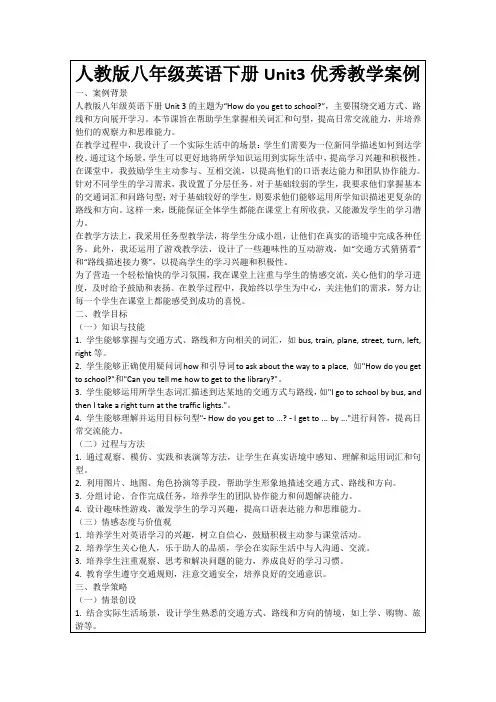
2.问题导向的教学策略:本节课通过设计具有启发性和思考性的问题,如"你能想到哪些交通方式?"和"当你不知道怎么去一个地方时,你会怎么办?",引导学生主动探究和发现知识。这种问题导向的教学策略不仅培养了学生的思维能力,还提高了他们的学习积极性。
4.教师在小组合作过程中进行巡视指导,关注学生的学习进度和需求,及时给予帮助和反馈。
(四)反思与评价
1.学生对自己在课堂上的表现进行反思,如对所学知识的理解和运用情况进行评估。
2.学生之间进行相互评价,发现他人的优点和不足,进行总结和借鉴。
3.教师对学生的学习情况进行评价,关注学生的进步和问题,为下一步教学提供参考。
4.教育学生遵守交通规则,注意交通安全,培养良好的交通意识。
三、教学策略
(一)情景创设
1.结合实际生活场景,设计学生熟悉的交通方式、路线和方向的情境,如上学、购物、旅游等。
2.使用图片、地图、道具等辅助材料,营造真实、生动的学习氛围。
3.角色扮演法,让学生扮演不同角色,如问路者、指路者等,进行实际交流互动。
为了营造一个轻松愉快的学习氛围,我在课堂上注重与学生的情感交流,关心他们的学习进度,及时给予鼓励和表扬。在教学过程中,我始终以学生为中心,关注他们的需求,努力让每一个学生在课堂上都能感受到成功的喜悦。
二、教学目标
(一)知识与技能
1.学生能够掌握与交通方式、路线和方向相关的词汇,如bus, train, plane, street, turn, left, right等。
(完整word版)人教版八年级英语下册第三单元教案
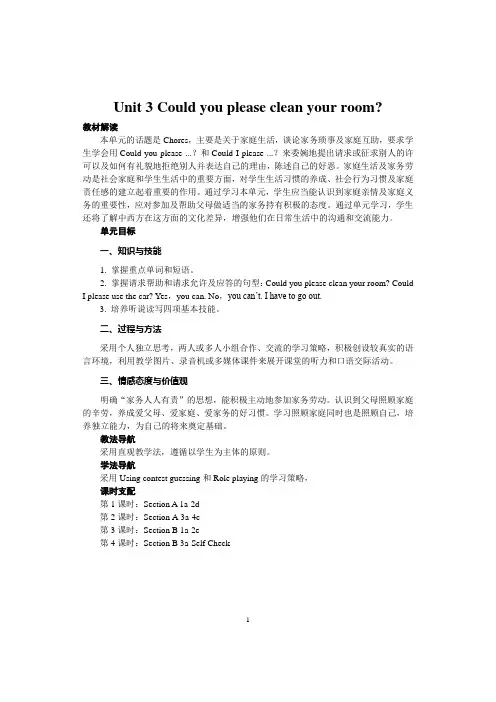
Unit 3 Could you please clean your room?教材解读本单元的话题是Chores,主要是关于家庭生活,谈论家务琐事及家庭互助,要求学生学会用Could you please ...?和Could I please ...?来委婉地提出请求或征求别人的许可以及如何有礼貌地拒绝别人并表达自己的理由,陈述自己的好恶。
家庭生活及家务劳动是社会家庭和学生生活中的重要方面,对学生生活习惯的养成、社会行为习惯及家庭责任感的建立起着重要的作用。
通过学习本单元,学生应当能认识到家庭亲情及家庭义务的重要性,应对参加及帮助父母做适当的家务持有积极的态度。
通过单元学习,学生还将了解中西方在这方面的文化差异,增强他们在日常生活中的沟通和交流能力。
单元目标一、知识与技能1. 掌握重点单词和短语。
2. 掌握请求帮助和请求允许及应答的句型:Could you please clean your room? CouldI please use the car? Yes,you can. No,you can’t. I have to go out.3. 培养听说读写四项基本技能。
二、过程与方法采用个人独立思考,两人或多人小组合作、交流的学习策略,积极创设较真实的语言环境,利用教学图片、录音机或多媒体课件来展开课堂的听力和口语交际活动。
三、情感态度与价值观明确“家务人人有责”的思想,能积极主动地参加家务劳动。
认识到父母照顾家庭的辛劳,养成爱父母、爱家庭、爱家务的好习惯。
学习照顾家庭同时也是照顾自己,培养独立能力,为自己的将来奠定基础。
教法导航采用直观教学法,遵循以学生为主体的原则。
学法导航采用Using contest guessing和Role playing的学习策略,课时支配第1课时:Section A 1a-2d第2课时:Section A 3a-4c第3课时:Section B 1a-2e第4课时:Section B 3a-Self Check1课时教案第1课时Section A 1a-2c教学目标一、知识与技能1. 掌握重点词汇和短语:do the dishes,take out the rubbish,fold your clothes,sweep the floor,make your bed,clean the living room2. 理解并掌握重点句型:Could you please…? Could I …?3. 能听懂有关做家务和日常活动的对话。
及分析人教版英语八年级下册Unit3大单元教学设计
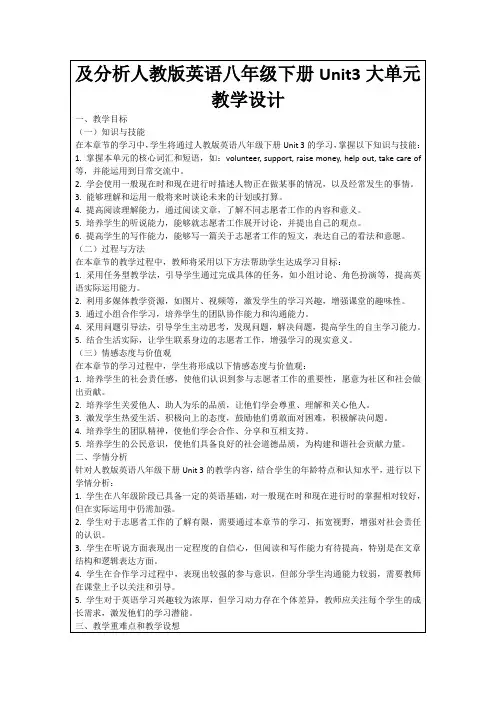
-定期组织展示活动,让学生在实践中展示自己的学习成果,增强自信心。
4.教学延伸:
-鼓励学生参与学校或社区的实际志愿者活动,将所学知识运用到实践中。
-建立学习小组,利用课后时间进行英语角活动,提高学生的语言实际运用能力。
-结合单元主题,开展跨学科活动,如社会调查、研究报告等,拓宽学生的学习视野。
4.口语作业:与家人或朋友进行一次关于志愿者工作的英语对话,尝试使用本节课学到的词汇和时态,记录下对话内容。
5.研究任务:选择一个感兴趣的志愿者组织或活动,通过网络或图书馆资源,了解该组织或活动的基本信息、活动宗旨和参与方式,下节课向同学分享。
作业布置注意事项:
-确保作业难度适中,既能巩固课堂所学,又不会给学生造成过重的负担。
四、教学内容与过程
(一)导入新课
在这一阶段,教师将运用多媒体资源,以生动有趣的方式导入新课。首先,在大屏幕上展示一组志愿者活动的图片,如环保清洁、帮助老人过马路等,让学生们观察并思考这些图片中的共同点。随后,提出问题:“What are they doing? Why do they do these things?”引导学生展开思考。
(二)过程与方法
在本章节的教学过程中,教师将采用以下方法帮助学生达成学习目标:
1.采用任务型教学法,引导学生通过完成具体的任务,如小组讨论、角色扮演等,提高英语实际运用能力。
2.利用多媒体教学资源,如图片、视频等,激发学生的学习兴趣,增强课堂的趣味性。
3.通过小组合作学习,培养学生的团队协作能力和沟通能力。
-通过真实语境的创设,让学生在实践中感受时态的用法,提高口语表达能力。
-引导学生通过预读、细读和总结等步骤,提高阅读理解能力。
八年级英语下册(人教版)Unit3单元整体优秀教学案例
1.创设真实语境,提升语言实践能力
本案例通过多媒体展示、角色扮演等多种形式,为学生创设了一个真实、有趣的旅游语境。在这样的环境中,学生能够更好地将所学知识应用于实际情境,提高英语语言实践能力,使课堂学习与生活实际紧密结合。
2.问题导向,培养问题解决能力
本案例以问题为导向,引导学生主动思考、分析和解决问题。这种方法有助于培养学生的批判性思维和问题解决能力,使学生在探讨中学习,提高英语综合运用能力。
(二)问题导向
以问题为导向的教学策略可以激发学生的思考,培养他们的问题解决能力。在本章节的教学中,我将设计一系列与旅游相关的问题,引导学生运用所学知识和生活经验进行分析和讨论。例如:“如果你要去国外旅行,你会选择哪些景点?”“在国外旅行时,如何用英语向当地人求助?”等问题。通过问题导向,让学生在探讨中学习,提高他们的英语应用能力。
4.提高学生的听力水平,使他们能理解并获取与旅游相关的信息。
5.培养学生的口语表达能力,使他们能在小组讨论和角色扮演等活动中,运用所学知识进行有效沟通。
(二)过程与方法
1.通过小组合作、讨论、分享等形式,让学生在实践中学习英语,提高他们的合作能力和解决问题的能力。
2.利用多媒体资源、网络素材等教学手段,丰富教学形式,激发学生的学习兴趣,提高他们的学习积极性。
3课本,了解本单元的学习内容,激发他们的学习兴趣。
(二)讲授新知
1.学习词汇:通过图片和例句,教授与旅游相关的词汇,如scenery, attraction, guide, itinerary等,让学生在实际情境中理解并运用这些词汇。
(三)小组合作
小组合作是一种有效的教学策略,可以培养学生的团队精神和沟通能力。在本章节的教学中,我将组织学生进行小组活动,共同完成旅游主题的任务。例如:设计一份旅游攻略、编写一段旅游宣传视频脚本等。学生在合作过程中,可以相互借鉴、相互学习,提高英语综合运用能力。
人教版英语八年级下册 Unit3_SectionA(1a-2d)教案
Unit3 SectionA(1a-2d)名师教案1.0Teaching Analysis教情分析1.1Teaching Objectives 教学目标1.1.1Language goals 语言目标1.1.1.1 Key Words and Chunks1.1.1.1.1 For applying: do the dishes, make the bed, take out the rubbish, foldthe clothes, sweep the floor, clean the living room, no problem, goout for dinner, go to the movies, stay out late, get a ride, have to, need,work on, help out with, at least, finish, any minute now1.1.1.1.2 For comprehending: stay out late, get a ride, have to, need, workon, help out with, at least, finish, any minute now1.1.1.3 Sentence Structures1)Could you please take out the rubbish?Sure. / Sorry, I can’t. I have to finish homework first.2) Could I use your computer?Sorry. I'm going to work on it now.3)Well, could I watch TV?Yes, you can. But first you have to clean your room.4)A nd she won’t be happy if she sees this mess.5) Could I at least finish watching this show?6)I think two hours of TV is enough for you .1.1.1.4Grammar Focus1)C ould for polite requestsA:Could you please take out the rubbish?B:OK, but I want to watch one show first.A:Could you please take out the rubbish?B:Yes, sure.2)C ould for permissionA:Could I go out for dinner with my friends?B:Sure, that should be OK.A:Could you get something to drink after the movie?B:No, you can’t. You have a basketball game to morrow.1.1.2Ability goals 能力目标1.1.2.1 教会学生用could礼貌地提出要求和征求许可。
最新人教版八年级下册英语精品教案设计Unit 3
Unit 3 Could you please clean your room?话题Topic 家务琐事与许可(Chores and permission)功能Functions1.能礼貌地提出要求2.能向别人征询许可语法Grammar1.能用could礼貌地提出要求(Could for polite requests)2.能用could征询许可(Could for permission )词汇和常用表达Words & expressions 1.能正确使用下列词汇 (按词性排列)rubbish,floor,mess,shirt,finger,snack,stress,waste,fairness, neighbor,fold,sweep,throw,pass,borrow,lend,hate,provide,depend,develop,drop,neither,anyway,ill,fair,unfair,while,since2.能正确使用下列常用表达take out the rubbish,all the time,as soon as,in order to,depend on,take care of3.能认读下列词汇chore,independence,independent学习策略Strategies 1.通过略读快速了解文章大意2.利用语块整体记忆词汇文化知识Culture 有关家务劳动三维目标Three-dimensionaltarget 知识与技能1.能掌握以下单词:rubbish,fold,sweep,floor,mess,throw,neither,shirt,pass,borrow,lend,finger,hate,while,stress,waste,provide,anyway,depend,develop,fairness,since,neighbor,ill,drop,fair,unfair2.熟练掌握短语:take out the rubbish,in order to,take care of,make one’sbed,stay out late,hang out,the earlier...,thebetter...,allthe time,depend on,as soon as,do the dishes,get a ride,comeover,be angry with,in surprise3.能掌握以下句型:Could you please do sth.?I have to do some work.Could I do sth.?She won’t be happy if she sees this mess.For one week,she did not do any housework and neither did I.My mom came over as soon as I sat down in front of the TV.主语+hate+(to do/doing) sth.4.学会用could 礼貌地请求和征求许可。
人教版PEP八年级下册英语教案Unit-3-第精选全文完整版
可编辑修改精选全文完整版第三课时Section A(Grammar Focus~4c)【学习目标】1.学生能学会本课时出现的生词及短语:pass,borrow,lend,finger,hate,chore,while,pass sb.sth.,lend sb.sth.,get it wet,hate to do sth.,borrow sth.from sb.2.教会学生熟练运用句型Could you please…?【学习重点】掌握句型Could you please…?与Could I…?以及单词borrow,lend 和hate的用法。
【学习难点】总结归纳提出请求,或请求允许的方法。
情景导入师生自由创设情境,扮演家庭成员,询问交流引入话题。
T:Could you please pass me the salt?S:Sure.Here you are.自学互研Task 1【组内小展示】先由各小组组长带领组内成员认读单词和词组,再在整个小组内进行齐读后对词汇的用法进行归纳,并标记出发音和理解困难的单词,可及时向老师求助。
最后,板书展示内容。
【班级大展示】1.I can read.(我会读)①带读——齐读,注意finger的发音;②通过游戏形式,如单词游戏来巩固单词的学习。
2.I can write.(我会写)①以answer quickly(抢答)的方式对词组进行中英互译;②带读——齐读;③抽测:可以用造句的方式巩固词组的用法。
3.I can practice.(我会练)①结合所学的could的用法,完成句子;②通过练习总结“Could you please…?”和“Could I please…?”的用法。
情景导入生成问题1.(T)Question:Could you please pass me that book?(S)Answer:________________________________________________________________________ 2.(T)Question:Could we finish reading this book together?(S)Answer:________________________________________________________________________自学互研生成能力Task 1Let's read the new words and phrases.1.I can read.(我会读)pass,borrow,lend,finger,hate,while,chore2.I can write.(我会写)(1)pass me the salt 递给我盐(2)come back too late 回来太晚(3)hate to do sth.讨厌做某事(4)finish reading 读完(5)hang out with my friends 与朋友闲逛(6)try(not)to do sth.尽量(不)做某事(7)get it wet 让它打湿(8)lend me some money借给我一些钱3.I can practice.(我会练)根据汉语意思完成下列句子,每空一词。
- 1、下载文档前请自行甄别文档内容的完整性,平台不提供额外的编辑、内容补充、找答案等附加服务。
- 2、"仅部分预览"的文档,不可在线预览部分如存在完整性等问题,可反馈申请退款(可完整预览的文档不适用该条件!)。
- 3、如文档侵犯您的权益,请联系客服反馈,我们会尽快为您处理(人工客服工作时间:9:00-18:30)。
教材解读 本单元的话题是 Chores,主要是关于家庭生活,谈论家务琐事及家庭互助,要求学
生学会用 Could you please ... ?和 Could I please ... ?来委婉地提出请求或征求别人的许 可以及如何有礼貌地拒绝别人并表达自己的理由,陈述自己的好恶。家庭生活及家务劳 动是社会家庭和学生生活中的重要方面,对学生生活习惯的养成、社会行为习惯及家庭 责任感的建立起着重要的作用。通过学习本单元,学生应当能认识到家庭亲情及家庭义 务的重要性,应对参加及帮助父母做适当的家务持有积极的态度。通过单元学习,学生 还将了解中西方在这方面的文化差异,增强他们在日常生活中的沟通和交流能力。
S1:Can you do the chores?
S2:Could you please do the chores?
T:Which one do you think is better?
2
T:Look at the picture on page 17. What can you see?
S1:Peter and his mother.
S2:The dudirty.
S4:...
T:So there are a lot of chores to do , right? Help students to learn the following phrases
单元目标 一、知识与技能 1. 掌握重点单词和短语。 2. 掌握请求帮助和请求允许及应答的句型: Could you please clean your room? Could I please use the car? Yes, you can. No , you can ’ t. I have to go out. 3. 培养听说读写四项基本技能。 二、过程与方法 采用个人独立思考,两人或多人小组合作、交流的学习策略,积极创设较真实的语 言环境,利用教学图片、录音机或多媒体课件来展开课堂的听力和口语交际活动。 三、情感态度与价值观 明确“家务人人有责”的思想,能积极主动地参加家务劳动。认识到父母照顾家庭 的辛劳,养成爱父母、爱家庭、爱家务的好习惯。学习照顾家庭同时也是照顾自己,培 养独立能力,为自己的将来奠定基础。 教法导航 采用直观教学法,遵循以学生为主体的原则。 学法导航 采用 Using contest guessing 和 Role playing 的学习策略, 课时支配 第 1 课时: Section A 1a-2d 第 2 课时: Section A 3a-4c 第 3 课时: Section B 1a-2e 第 4 课时: Section B 3a-Self Check
2. 理解并掌握重点句型: Could you please… ? Could I … ? 3. 能听懂有关做家务和日常活动的对话。 二、过程与方法
采用情境教学法,调动学生的积极性,引导他们积极参与课堂。
三、情感态度与价值观
了解各种家务,能发现要做的家务并积极主动地去做。 教学重点 能用本课的重点词汇和句型对家务作出委婉请求。 教学难点 能抓住录音中的关键词。 教法导航 课上引导学生积极参与课堂活动,老师少讲,鼓励学生多练。 学法导航 加强小组合作学习,积极回答问题。 教学准备 图片,录音机,多媒体。 教学过程 Step 1 Greetings Greet the students as usual. Step 2 Lead-in T:Good morning ,boys and girls! I am always very busy on weekends. So my daughter often helps me with the housework. Do you often help your mother do the chores at home? (Write “ chores” on blackboard and explain it.) Here “ chore” means housework. Could you please tell me what chores you do at home? S1:I often clean my room. S2:I wash my clothes and fold my clothes. S3:I clean the window. S4:I make my bed and sweep the floor. S5:I clean the living room. T:Well , you are good boys and girls! We should try to be helpful and do some chores at home. Step 3 New words and expressions Ask the students to look at the picture on Page 17.
课时教案
1
第 1 课时 Section A 1a-2c
教学目标
一、知识与技能
1. 掌握重点词汇和短语: do the dishes,take out the rubbish ,fold your clothes ,sweep the floor , make your bed ,clean the living room
about chores:clean the living room; do the dishes; sweep the floor; make the bed; take out the
trash; fold the clothes
Step 4 Presentation
T:If you want to ask somebody to do chores , how can you ask in English?
